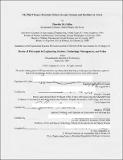The MQ-9 Reaper remotely piloted aircraft : humans and machines in action
Author(s)
Cullen, Timothy M
DownloadFull printable version (4.225Mb)
Other Contributors
Massachusetts Institute of Technology. Technology, Management, and Policy Program.
Advisor
David A. Mindell.
Terms of use
Metadata
Show full item recordAbstract
Remotely piloted aircraft and the people that control them are changing how the US military operates aircraft and those who fly, yet few know what "drone" operators actually do, why they do what they do, or how they shape and reflect remote air warfare and human-machine relationships. What do the remote operators and intelligence personnel know during missions to "protect and avenge" coalition forces in Iraq and Afghanistan and how do they go about knowing what they know? In an ethnographic and historical analysis of the Air Force's preeminent weapon system for the counterinsurgencies in the two countries, this study describes how social, technical, and cognitive factors mutually constitute remote air operations in war. Armed with perspectives and methods developed in the fields of the history of technology, sociology of technology, and cognitive anthropology, the author, an Air Force fighter pilot, describes how distributed crews represent, transform, and propagate information to find and kill targets and traces the observed human and machine interactions to policy assumptions, professional identities, employment concepts, and technical tools. In doing so, he shows how the people, practices, and machines associated with remotely piloted aircraft have been oriented to and conditioned by trust in automation, experience, skill, and social interactions and how they have influenced and reflected the evolving operational environment, encompassing organizations, and communities of practice.
Description
Thesis (Ph. D. in Technology, Management and Policy)--Massachusetts Institute of Technology, Engineering Systems Division, Technology, Management, and Policy Program, 2011. Cataloged from PDF version of thesis. This version of the catalog record was uploaded July 2013. Includes bibliographical references.
Date issued
2011Department
Massachusetts Institute of Technology. Engineering Systems Division; Technology and Policy ProgramPublisher
Massachusetts Institute of Technology
Keywords
Engineering Systems Division., Technology, Management, and Policy Program.